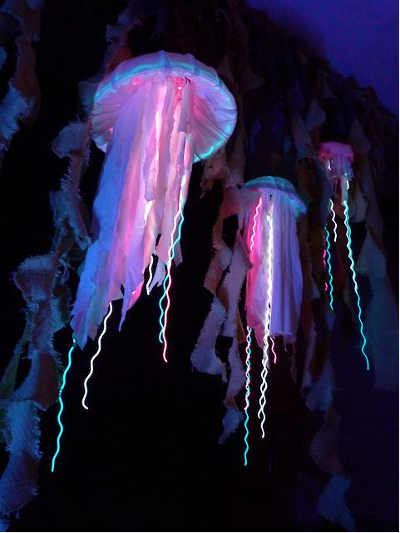Bioluminescence is the generation and discharge of light by a living being. Most bioluminescent species are marine creatures such as jellyfish, molluscs, fish, and brittle stars (a relative of the starfish). Bioluminescent land species include bacteria, fungi, worms, and fireflies. Very few light-emitting species live in freshwater environments.
Single-celled dinoflagellates such as plankton are the most abundant light-emitting organisms found in the oceans. These creatures flash a bluish-green light for a tenth of a second when stimulated by the presence of copepods, the small crustaceans that feed on them. They also illuminate in response to the movement of ocean waves.
 Biologists believe that the flash startles predators and interrupts them as they feed on the dinoflagellates. The flash also makes makes the copepods more conspicuous to their own predators, such as whales. The phenomenon may also help more complex organisms find and recognize each other in the darkness of the deep sea. The light organs, or photophores, of many bioluminescent fish are arranged in patterns that could create species and sex-recognition signals when illuminated. While the purpose of microbial bioluminescence is unknown, researchers believe it may have evolved long ago as an adaptation for removing oxygen from the environment.
Biologists believe that the flash startles predators and interrupts them as they feed on the dinoflagellates. The flash also makes makes the copepods more conspicuous to their own predators, such as whales. The phenomenon may also help more complex organisms find and recognize each other in the darkness of the deep sea. The light organs, or photophores, of many bioluminescent fish are arranged in patterns that could create species and sex-recognition signals when illuminated. While the purpose of microbial bioluminescence is unknown, researchers believe it may have evolved long ago as an adaptation for removing oxygen from the environment.
Bioluminescence is a form of chemiluminescence in which light is produced by a chemical reaction that occurs within the organism. It involves very efficient reactions that give off little to no heat. For this reason, bioluminescence is referred to as “cold light.”
These reactions require the presence of luciferin and oxygen. Most bioluminescent reactions also require the enzyme luciferase. Luciferase produces light upon interacting with oxidized (oxygen-added) luciferin. However, the reactions of other light-emitting species such as crystal jellies are based on a chemical called photoprotein, rather than luciferase. While many produce light on their own, others light up due to the presence of bioluminescent bacteria in their guts.
Different organisms may produce light of different wavelengths. While most bioluminescent organisms emit bluish-green shades of light, some glow red. Most creatures flash for less than ten seconds.
Bioluminescence differs from photoluminescence, a process in which matter simply absorbs and re-radiates prior emissions of light from external sources.
Photo credit: Jason Eppink, Flickr